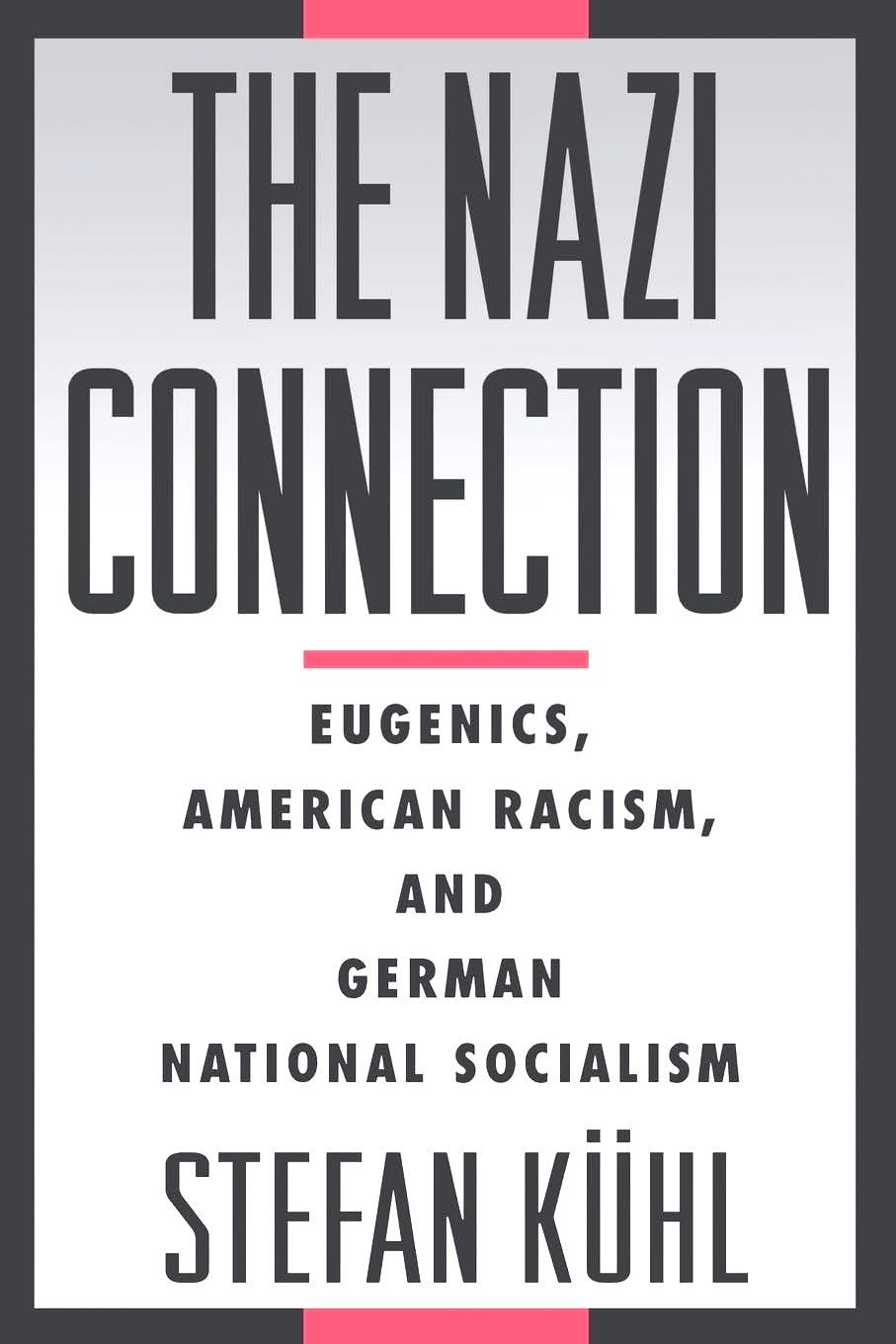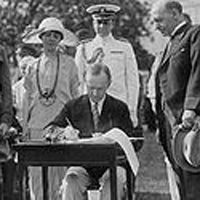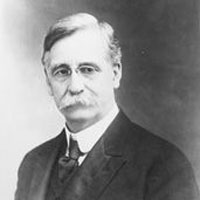
シュテファン・キュール『ナチ・コネクション』ノート
Stefan Kühl's The Nazi connection :
eugenics, American racism, and German national socialism, 1994.
★キュール、S.『ナチ・コネクション : アメリカの優生学とナチ優生思想』麻生九美訳、明石書店、1999年の読書ノート
| 1)「新しい」科学的人種主義 |
・科学人種主義の歴史 |
| 2)1933年以前の国際優生学運動におけるドイツとアメリカの関係 |
|
| 3)国際的な背景—国際優生学運動を通じて支持されたナチの人種政策 |
|
| 4)弟子からモデルへ—ドイツと合衆国の断種 |
|
| 5)ナチ・ドイツを訪問したアメリカの優生学者たち |
|
| 6)科学と人種主義—人種概念の相違がナチの人種政策に対する姿勢にお
よぼした影響 |
|
| 7)合衆国の優生学を変化させたナチの人種政策 |
|
| 8)ナチ・ドイツがアメリカの支持を求めたことと、アメリカの支持が果
たした役割について |
|
| 9)ドイツとアメリカの優生学者の関係の一時的な途絶 |
|
| When Hitler published Mein Kampf
in 1924, he held up a foreign law as a model for his program of racial
purification: The U.S. Immigration Restriction Act of 1924,
which prohibited the immigration of those with hereditary illnesses and
entire ethnic groups. When the Nazis took power in 1933, they installed
a program of eugenics-the attempted "improvement" of the population
through forced sterilization and marriage controls-that consciously
drew on the U.S. example. By then, many American states had long had compulsory sterilization laws for "defectives," upheld by the Supreme Court in 1927. Small wonder that the Nazi laws led one eugenics activist in Virginia to complain, "The Germans are beating us at our own game." In The Nazi Connection, Stefan Kuhl uncovers the ties between the American eugenics movement and the Nazi program of racial hygiene, showing that many American scientists actively supported Hitler's policies. After introducing us to the recently resurgent problem of scientific racism, Kuhl carefully recounts the history of the eugenics movement, both in the United States and internationally, demonstrating how widely the idea of sterilization as a genetic control had become accepted by the early twentieth century. From the first, the American eugenicists led the way with radical ideas. Their influence led to sterilization laws in dozens of states-laws which were studied, and praised, by the German racial hygienists. With the rise of Hitler, the Germans enacted compulsory sterilization laws partly based on the U.S. experience, and American eugenists took pride in their influence on Nazi policies. Kuhl recreates astonishing scenes of American eugenicists travelling to Germany to study the new laws, publishing scholarly articles lionizing the Nazi eugenics program, and proudly comparing personal notes from Hitler thanking them for their books. Even after the outbreak of war, he writes, the American eugenicists frowned upon Hitler's totalitarian government, but not his sterilization laws. So deep was the failure to recognize the connection between eugenics and Hitler's genocidal policies, that a prominent liberal Jewish eugenicist who had been forced to flee Germany found it fit to grumble that the Nazis "took over our entire plan of eugenic measures." By 1945, when the murderous nature of the Nazi government was made perfectly clear, the American eugenicists sought to downplay the close connections between themselves and the German program. Some of them, in fact, had sought to distance themselves from Hitler even before the war. But Stefan Kuhl's deeply documented book provides a devastating indictment of the influence-and aid-provided by American scientists for the most comprehensive attempt to enforce racial purity in world history. - https://ci.nii.ac.jp/ncid/BA83803709 |
ヒトラーは、1924年に『我が闘争』を出
版する際、人種浄化計画のモデルとして、ある外国の法律を持ち出した。1924年のアメリカ移民制限法は、遺伝性疾患を持つ者や民族全体の移民を禁止して
いた。1933年にナチスが政権を握ると、強制的な不妊手術や結婚の規制を通じて、人口を「改良」しようとする優生学プログラムを導入したが、これは意識
的にアメリカの例を引き合いに出したものであった。 その頃、アメリカの多くの州では、1927年に最高裁が支持した「不良品」に対する強制不妊手術法が以前から存在していた。ナチスの法律が、バージニア州 のある優生学活動家に、"ドイツ人は我々のゲームで我々を負かす "と苦言を呈させたのも不思議はない。 ステファン・クール(キュール)は『ナチ・コネクション』の中で、アメリカの優生学運動とナチスの人種衛生計画との関係を明らかにし、多くのアメリカの科 学者がヒトラーの政策を積極的に支持していたことを明らかにしている。 最近になって復活した科学的人種差別の問題を紹介した後、クールはアメリカ国内および国際的な優生学運動の歴史を丁寧に語り、遺伝子操作としての不妊手術 の考え方が20世紀初頭までにいかに広く受け入れられたかを示している。 当初から、アメリカの優生学者が過激な思想で道を切り開いていった。この法律は、ドイツの人種衛生学者たちによって研究され、賞賛された。ヒトラーの台頭 により、ドイツはアメリカの経験を一部取り入れた強制不妊手術法を制定し、アメリカの優生学者がナチスの政策に影響を与えたと自負している。 クール(キュール)は、アメリカの優生学者がドイツに渡って新しい法律を研究し、ナチスの優生学プログラムを賞賛する学術論文を発表し、ヒトラーから受け 取った自分の本に対する感謝の手紙を誇らしげに比較する驚くべき場面を再現している。戦争が始まった後も、アメリカの優生学者たちは、ヒトラーの全体主義 的な政府には眉をひそめるが、不妊手術の法律には眉をひそめない、と彼は書いている。 優生学とヒトラーの大量虐殺政策との関連性を深く認識しなかったために、ドイツから脱出を余儀なくされたある著名なリベラル派のユダヤ人優生学者(→リチャード・ゴールドシュミットのこと)は、ナチスが「我々の優生学対策の 計画をすべて引き継いでしまった」と不平を言うにふさわしいと判断している。 1945年になって、ナチス政府の殺人的性質が完全に明らかになると、アメリカの優生学者たちは、自分たちとドイツのプログラムとの密接な関係を軽視しよ うとした。実際、彼らの中には戦前からヒトラーから距離を置こうとする者もいた。しかし、シュテファン・クールの深く掘り下げた本書は、世界史上最も包括 的な人種的純度の強制の試みに、アメリカの科学者が与えた影響と援助について、破壊的な告発をしている。 |
| For the betterment of the race :
the rise and fall of the international
movement for eugenics and racial hygiene, Stefan Kühl ; translated by
Lawrence Schofer. Palgrave Macmillan 2013. |
|
| Racism, race hygiene, eugenics, and their histories have for a long time been studied in terms of individual countries, whether genocidal ideology in Nazi Germany or scientific racial theories in the United States. As this study demonstrates, however, eugenic racial policy and scientific racism alike had a strongly international dimension. Concepts such as a 'Racial Confederation of European Peoples' or a 'blonde internationalism' marked the thinking and the actions of many eugenicists, undergirding transnational networks that persist even today. Author Stefan Kuhl provides here a historical foundation for this phenomenon, contextualizing the international eugenics movement in relation to National Socialist race policies and showing how intensively eugenicists worked to disseminate their beliefs throughout the world. - https://ci.nii.ac.jp/ncid/BC05079549 | 人種主義、人種衛生、優生学、およびそれらの歴史は、ナチス・ドイツの
大量虐殺思想やアメリカの科学的人種理論など、長い間、個々の国を対象として研究されてきた。しかし、本研究が示すように、優生学的人種政策と科学的人種
主義は、同様に強い国際的側面をもっていた。ヨーロッパ民族の人種同盟」や「ブロンド国際主義」といった概念は、多くの優生主義者の思考と行動を特徴づ
け、今日でも続く国境を越えたネットワークの根底を支えていたのである。著者のステファン・クール(キュール)は、この現象の歴史的基盤を提供し、国際的
な優生学運動を国家社会主義の人種政策と関連づけ、優生学者がその信念を世界中に広めるためにいかに集中的に活動したかを示している。 |
| 1. The Dream of the Genetic
Improvement of Mankind:The Formation of the International Eugenics
Movement 2. World War I and Its Effect on International Eugenics 3. Racism, Internationalism, and Eugenics 4. The Crisis of Orthodox Eugenics and the Rise of Human Genetics and Population Science 5. National Socialist Germany and the National Eugenics Movement 6. World War II and the Mass Murder of the Sick and Handicapped 7. On 'Good' and 'Bad' Eugenics: The Reorientation to Human Genetic Counseling and the Struggle Against 'Overpopulation' 8. The Renaissance of Racist Eugenics 9. The Dissolution of the Eugenics Movement: Will There Be Eugenics Without Eugenicists? |
1. 人類の遺伝子改良の夢-国際優生学運動の形成 2. 第一次世界大戦とその国際優生学への影響 3. 3. 人種主義、国際主義、優生学 4. 正統派優生学の危機と人類遺伝学・人口学の台頭 5. 5. 国家社会主義ドイツと国民優生学運動 6. 第二次世界大戦と病人・身体障害者の大量殺戮 7. 良い」優生学と「悪い」優生学について。ヒト遺伝カウンセリングへの方向転換と「過剰人口」に対する闘争 8. 人種差別的優生学のルネサンス 9. 優生学運動の解散。優生学者なき優生学はあり得るか? |
The Immigration Act of 1924 (The Johnson-Reed Act),


The Immigration Act of 1924 (The Johnson-Reed Act), President Coolidge signing the Johnson-Reed Act, Literacy Tests and “Asiatic Barred Zone”/ Senator William P. Dillingham
| The Immigration Act of 1924 (The
Johnson-Reed Act) |
1924年の移民法 |
| The
Immigration Act of 1924 limited the number of immigrants allowed entry
into the United States through a national origins quota. The quota
provided immigration visas to two percent of the total number of people
of each nationality in the United States as of the 1890 national
census. It completely excluded immigrants from Asia. |
1924年の移民法では、国籍枠によって米国への入国を許可される移民
の数が制限された。この枠は、1890年の国勢調査における合衆国内の各国籍者の総数の2パーセントに移民ビザを与えるものであった。アジアからの移民は
完全に排除された。 |
| In
1917, the U.S. Congress enacted the first widely restrictive
immigration law. The uncertainty generated over national security
during World War I made it possible for Congress to pass this
legislation, and it included several important provisions that paved
the way for the 1924 Act. The 1917 Act implemented a literacy test that
required immigrants over 16 years old to demonstrate basic reading
comprehension in any language. It also increased the tax paid by new
immigrants upon arrival and allowed immigration officials to exercise
more discretion in making decisions over whom to exclude. Finally, the
Act excluded from entry anyone born in a geographically defined
“Asiatic Barred Zone” except for Japanese and Filipinos. In 1907, the
Japanese Government had voluntarily limited Japanese immigration to the
United States in the Gentlemen’s Agreement. The Philippines was a U.S.
colony, so its citizens were U.S. nationals and could travel freely to
the United States. China was not included in the Barred Zone, but the
Chinese were already denied immigration visas under the Chinese
Exclusion Act. |
1917年、米国議会は初めて広く制限的な移民法を制定し
た。第一次世界大戦中の国家安全保障に対する不安から、議会はこの法律を成立させることができ、この法律には1924年の法律への道を開くいくつかの重要
な条項が含まれていた。1917年法では、16歳以上の移民にあらゆる言語で基本的な読解力を証明することを義務づける識字テストを実施した。また、移民
が到着した際に支払う税金を増やし、誰を排除するかについて移民局員の裁量を認めるというものであった。最後に、この法律は、地理的に定義された「アジア
禁制区」で生まれた者は、日本人とフィリピン人を除き、入国を禁止した。1907年、日本政府は紳士協定で日本人の米国への移民を自主的に制限していた。
フィリピンはアメリカの植民地であったので、その国民はアメリカ国民であり、自由にアメリカに渡航することができた。中国は禁輸区に含まれていなかった
が、中国人はすでに中国人排斥法によって移民ビザを拒否されていた。 |
| Immigration Quotas The literacy test alone was not enough to prevent most potential immigrants from entering, so members of Congress sought a new way to restrict immigration in the 1920s. Immigration expert and Republican Senator from Vermont William P. Dillingham introduced a measure to create immigration quotas, which he set at three percent of the total population of the foreign-born of each nationality in the United States as recorded in the 1910 census. This put the total number of visas available each year to new immigrants at 350,000. It did not, however, establish quotas of any kind for residents of the Western Hemisphere. President Wilson opposed the restrictive act, preferring a more liberal immigration policy, so he used the pocket veto to prevent its passage. In early 1921, the newly inaugurated President Warren Harding called Congress back to a special session to pass the law. In 1922, the act was renewed for another two years. |
移民割当 識字テストだけでは多くの移民を防ぐことはできないため、1920年代には議会は移民を制限する新たな方法を模索した。移民専門家でバーモント州選出の共 和党上院議員ウィリアム・P・ディリンガムは、移民定員を設ける法案を提出し、1910年の国勢調査で記録されたアメリカ国内の外国出身者の総人口の3 パーセントに設定した。これにより、毎年新規移民に発給されるビザの総数が35万人となった。しかし、西半球の住民に対しては、いかなる割当も行わなかっ た。ウィルソン大統領は、この制限的な法律に反対し、より自由な移民政策を好むため、ポケット・ベット(懐柔策)を用いてその成立を阻んだ。1921年初 頭、新たに就任したウォーレン・ハーディング大統領は、議会を臨時会に召還し、この法律を成立させた。1922年、この法律はさらに2年間更新された。 |
| When
the congressional debate over immigration began in 1924, the quota
system was so well-established that no one questioned whether to
maintain it, but rather discussed how to adjust it. Though there were
advocates for raising quotas and allowing more people to enter, the
champions of restriction triumphed. They created a plan that lowered
the existing quota from three to two percent of the foreign-born
population. They also pushed back the year on which quota calculations
were based from 1910 to 1890. |
1924年に移民に関する議会での議論が始まったとき、割
当制度はあまりにも定着していたため、これを維持するかどうかを問う人はおらず、むしろどのように調整するかが議論されていた。定員を増やし、より多くの
人の入国を認めるべきだという意見もあったが、制限の主張が勝った。外国人の受け入れ枠を3%から2%へ引き下げるという案が出された。また、外国人受け
入れの基準年を1910年から1890年に早めた。 |
| Another
change to the quota altered the basis of the quota calculations. The
quota had been based on the number of people born outside of the United
States, or the number of immigrants in the United States. The new law
traced the origins of the whole of the U.S. population, including
natural-born citizens. The new quota calculations included large
numbers of people of British descent whose families had long resided in
the United States. As a result, the percentage of visas available to
individuals from the British Isles and Western Europe increased, but
newer immigration from other areas like Southern and Eastern Europe was
limited. |
もう一つの変更点は、割当数の計算基準を変更したことであ
る。それまでは、米国外で生まれた人の数、つまり米国に移民した人の数に基づいて枠が決められていた。新しい法律では、自然生れの市民を含むアメリカ人全
体の出自をたどることになった。新しい枠の計算には、家族が長く米国に居住していた英国系の人々が大量に含まれていた。その結果、イギリス諸島や西ヨー
ロッパの出身者が取得できるビザの割合は増えたが、南・東ヨーロッパなど他の地域からの新規の移民は制限されることになった。 |
| The
1924 Immigration Act also included a provision excluding from entry any
alien who by virtue of race or nationality was ineligible for
citizenship. Existing nationality laws dating from 1790 and 1870
excluded people of Asian lineage from naturalizing. As a result, the
1924 Act meant that even Asians not previously prevented from
immigrating – the Japanese in particular – would no longer be admitted
to the United States. Many in Japan were very offended by the new law,
which was a violation of the Gentlemen’s Agreement. The Japanese
government protested, but the law remained, resulting in an increase in
existing tensions between the two nations. Despite the increased
tensions, it appeared that the U.S. Congress had decided that
preserving the racial composition of the country was more important
than promoting good ties with Japan. |
1924年の移民法には、人種や国籍によって市民権を得る
ことができない外国人を入国させないという規定もあった。1790年と1870年に制定された既存の国籍法は、アジア系の人々を帰化の対象から除外してい
た。その結果、1924年の法律では、これまで移民を妨げられていなかったアジア人、特に日本人が米国に入国できなくなったのである。日本では、紳士協定
に違反するこの新法に強い不快感を抱く者が多かった。日本政府は抗議したが、この法律はそのまま残り、日米間の緊張を高める結果となった。しかし、アメリ
カ議会は、日本との友好関係よりも、自国の人種構成を維持することの方が重要であると判断したようである。 |
| The
restrictive principles of the Act could have resulted in strained
relations with some European countries as well, but these potential
problems did not appear for several reasons. The global depression of
the 1930s, World War II, and stricter enforcement of U.S. immigration
policy served to curtail European emigration. When these crises had
passed, emergency provisions for the resettlement of displaced persons
in 1948 and 1950 helped the United States avoid conflict over its new
immigration laws. |
この法律の制限的な原則は、いくつかのヨーロッパ諸国との
関係にも緊張をもたらすことができたが、いくつかの理由により、このような潜在的な問題は現われなかった。1930年代の世界恐慌、第二次世界大戦、そし
てアメリカの移民政策の厳格化により、ヨーロッパからの移民は抑制されることになった。これらの危機が去った後、1948年と1950年に避難民の再定住
のための緊急規定が設けられ、米国は新しい移民法をめぐる対立を回避することができた。 |
| In all
of its parts, the most basic purpose of the 1924 Immigration Act was to
preserve the ideal of U.S. homogeneity. Congress revised the Act in
1952. |
1924年の移民法の最も基本的な目的は、そのすべての部分において、
米国の同質性という理想を維持することであった。議会は1952年にこの法律を改正した。 |
| https://history.state.gov/milestones/1921-1936/immigration-act |
https://www.deepl.com/ja/translator |
+++
Links
リンク
文献
その他の情報



++
Copyleft,
CC, Mitzub'ixi Quq Chi'j, 1996-2099